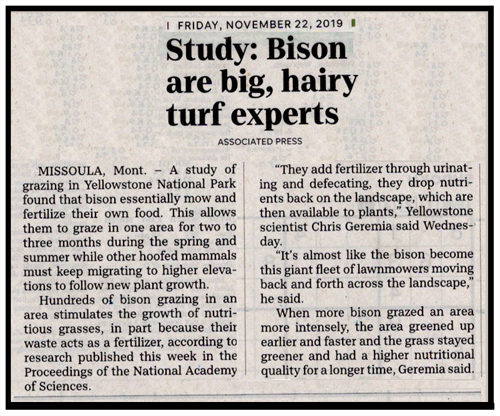Hooves and Dirt
Column #223
The media frustrates me to no end. Not only do they muddle up nutritional science, they also misrepresent agricultural science. I believe that happens because most reporters have, for a lack of better words, myopic “feel-good” viewpoints, alarmist reactions to climate change, and an urban understanding of how food is produced. Feelings and beliefs are the antitheses of nutritional and agricultural sciences. Unfortunately many consumers are influenced by happy talk, scaremongering, outright deception, and entertainment “news.” For that reason when it comes to the truth, and nothing but the truth, they rarely get the proper big picture.1
Last week my local newspaper ran a short Associated Press story about the environmental benefits that occur when Bison graze the landscape. (CNN put out a much longer article. CNN used to be a Ted Turner company and he owns 51,000 head of Bison on two million acres.) The AP article’s slant was that Bison are nearly magical in how they interact positively with the environment. Of course this resonates with everyone in this age of environmental sensitivity, global warming concerns, and wild animal preservation. That’s not a bad thing, but what is not mentioned in the article is the problem.2 3 4
The article stopped short of the most important message it could send. The missing message is that bison are similar to other ruminants such as the many varieties of wild and domesticated livestock that also graze the landscape. In other words, all ruminant species have a positive impact on soils. Also ignored was that to optimize yields all of these critters require sophisticated grazing management practices that effectively match the livestock to the natural resources.
For quite a few years now the media and various groups have been pounding the drums about how cattle in particular are destroying the planet. They’ve been saying that pastures should be converted to crops and cattle should be banned. This is so ignorant it staggers the mind of those of us who are tuned into the big picture.
The Natural Resources Conservation Service of the USDA says it this way: “Range and pasture lands are diverse types of land where the primary vegetation produced is herbaceous plants and shrubs. These lands provide forage for beef cattle, dairy cattle, sheep, goats, horses and other types of domestic livestock.” Generally speaking range land is not the best for raising crops. In addition from what I can tell, we do not need more vegetables because there is no shortage of plant-based foods anywhere in America. In fact, in our country a tremendous quantity of grain, vegetables, nuts, seeds, and fruit are thrown away!5
Just like Bison, all ruminants have a symbiotic relationship with the land and the vegetation that grows on it. Because livestock can thrive on grasses and shrubs, our range lands and pastures produce meat, especially grass-fed meat, which is the world’s most nutritious food for man. That in itself is a miracle. Because the range lands can be utilized by livestock of all kinds, the presence of these animals is a huge positive for the land in exactly the same way as it is with Bison. But in every case livestock grazing pastures must be managed to optimize returns.6
All livestock (including Bison) produce methane gas. But methane slowly dissipates over time and carbon gases are taken in by the vegetation as it grows back. And because of natural fertilization and the scuffing of the ground by hooves, the vegetation grows back with more vigor than if it had been left to grow, mature, die, and eventually rot producing methane gas.7
Searches of the internet show that there is a movement to value Bison over domestic livestock in the ecosystem. But the comparisons are not based on production (the conversion of pounds of forage to pounds of meat), the relative merits of palatability, and the economics which includes affordability. In addition, what is often ignored is that most of the Bison consumed in the USA come from feedlots just like the cattle!
I’m not against Bison as a meat crop. But I am against the idea that Bison have a better symbiotic relationship with mother nature than other ruminants that are adapted to their region’s environment. Quite often Bison are not managed as intensely as cattle. Consequently direct comparisons are not valid such as which species of animals will eat flowers. When Bison were roaming the plains 200 years ago, they were so numerous that, as they roamed, they caused considerable destruction to the landscape and waterways with over grazing and fouling. Today those “natural” grazing practices are not permitted by good stewards of the land.
Keeping ruminants on pastures and the open range is good for the environment. That has been the way for millions of years, long before man came along.
To your health.
Ted Slanker
Ted Slanker has been reporting on the fundamentals of nutritional research in publications, television and radio appearances, and at conferences since 1999. He condenses complex studies into the basics required for health and well-being. His eBook, The Real Diet of Man, is available online.
For additional reading:
1. The Environmental Impact Of Your Thanksgiving Dinner by Alexandra Emanuelli from the HuffPost
2. Why Bringing Back Bison Could Help Restore America's Lost Prairie from CNN
4. American Bison from Wikipedia
5. Range & Pasture from Natural Resources Conservation Service of the USDA
6. The Hysterical Meat Debate by Ted Slanker
7. The Role of Ruminants in Reducing Agriculture’s Carbon Footprint in North America by W.R. Teague, et al.




